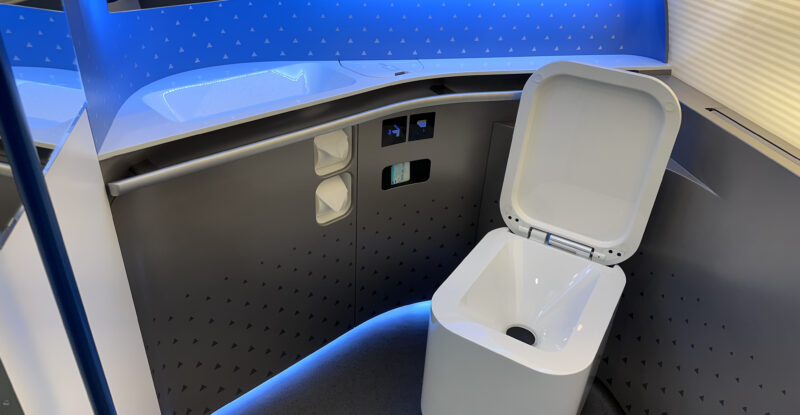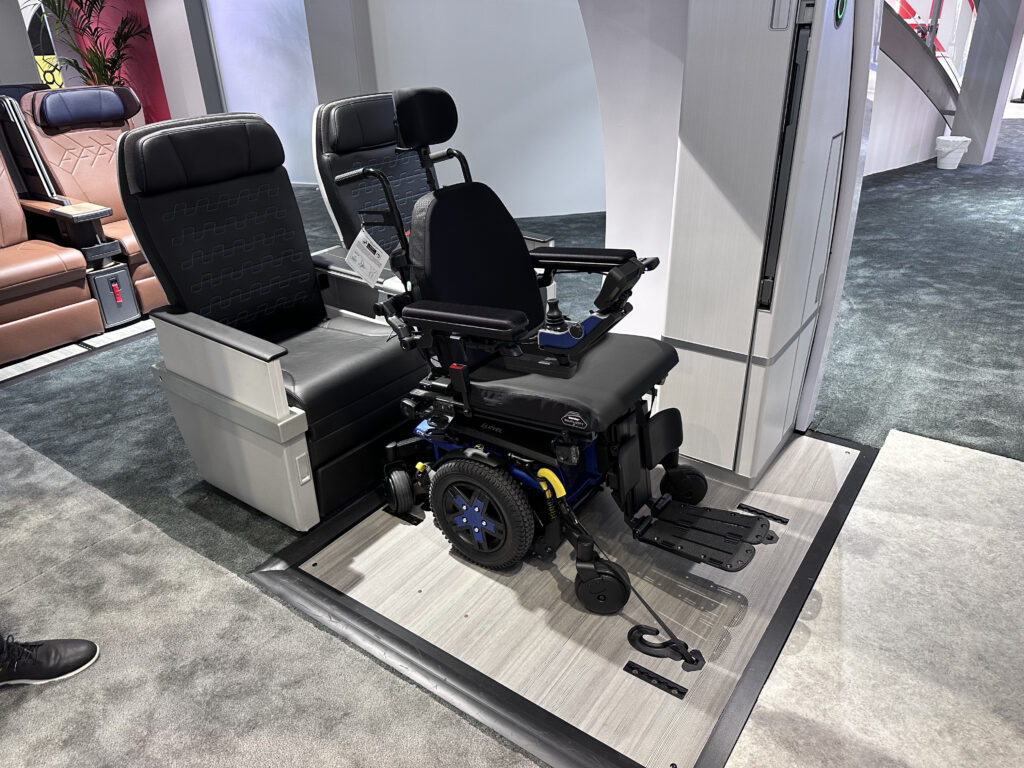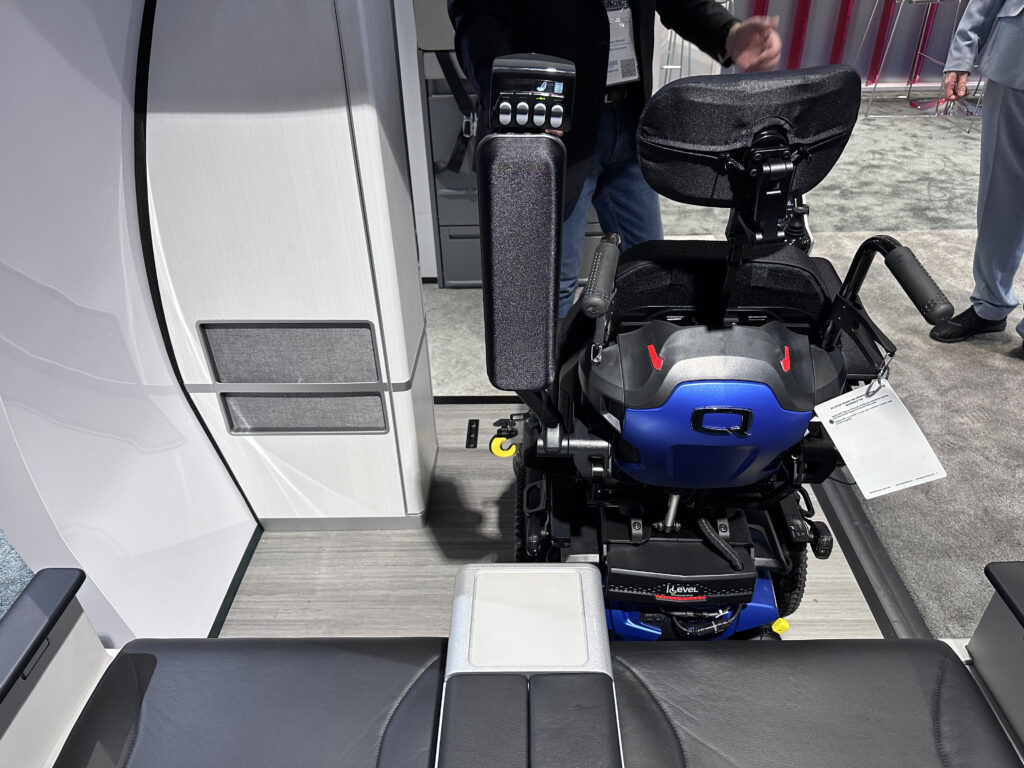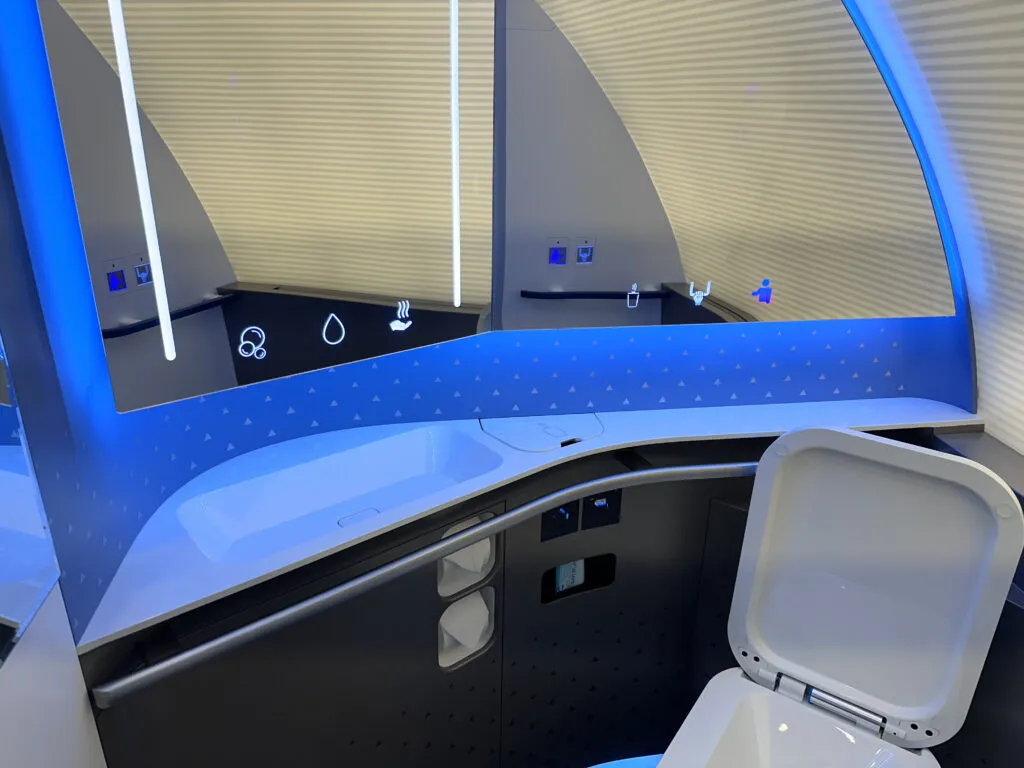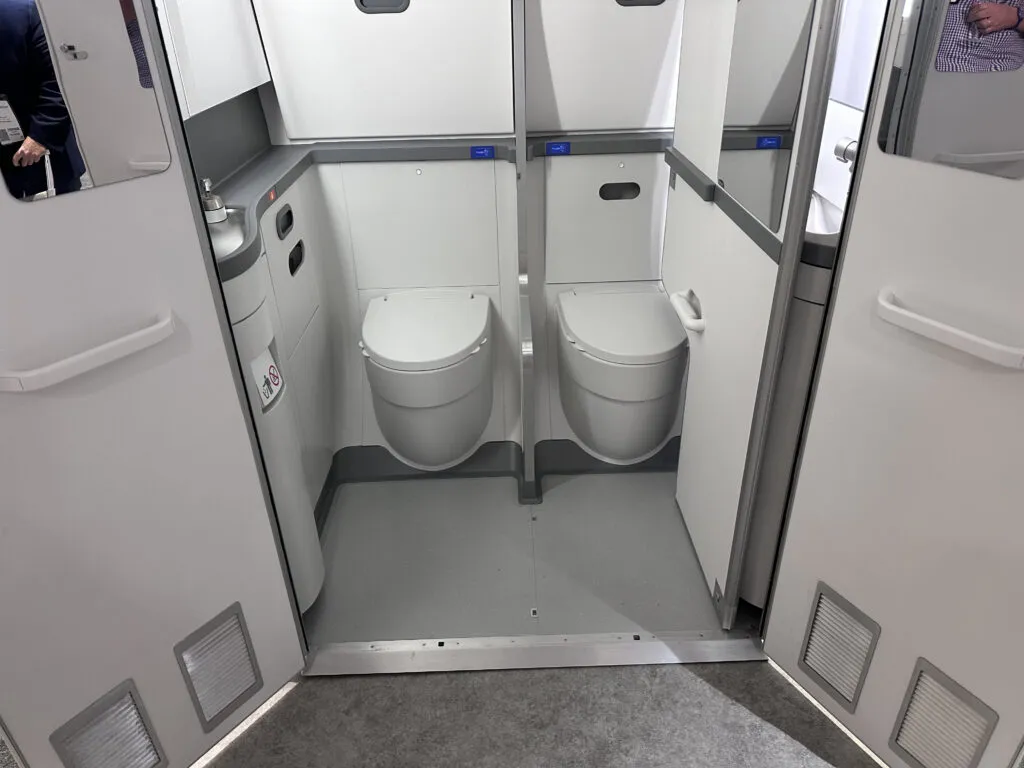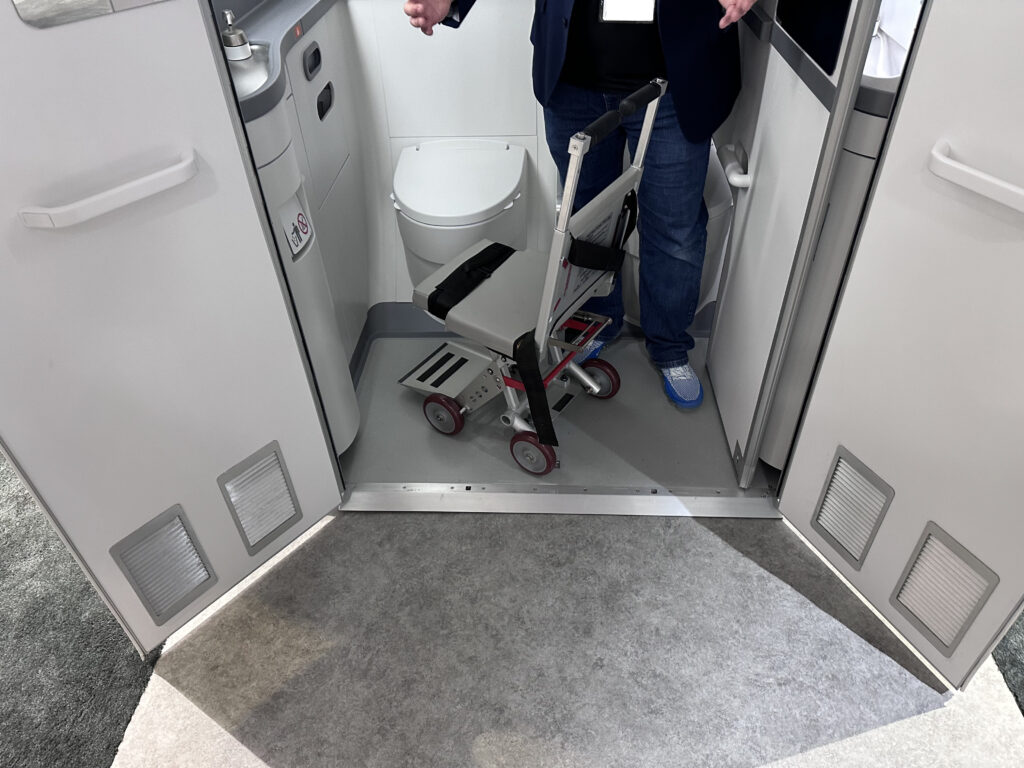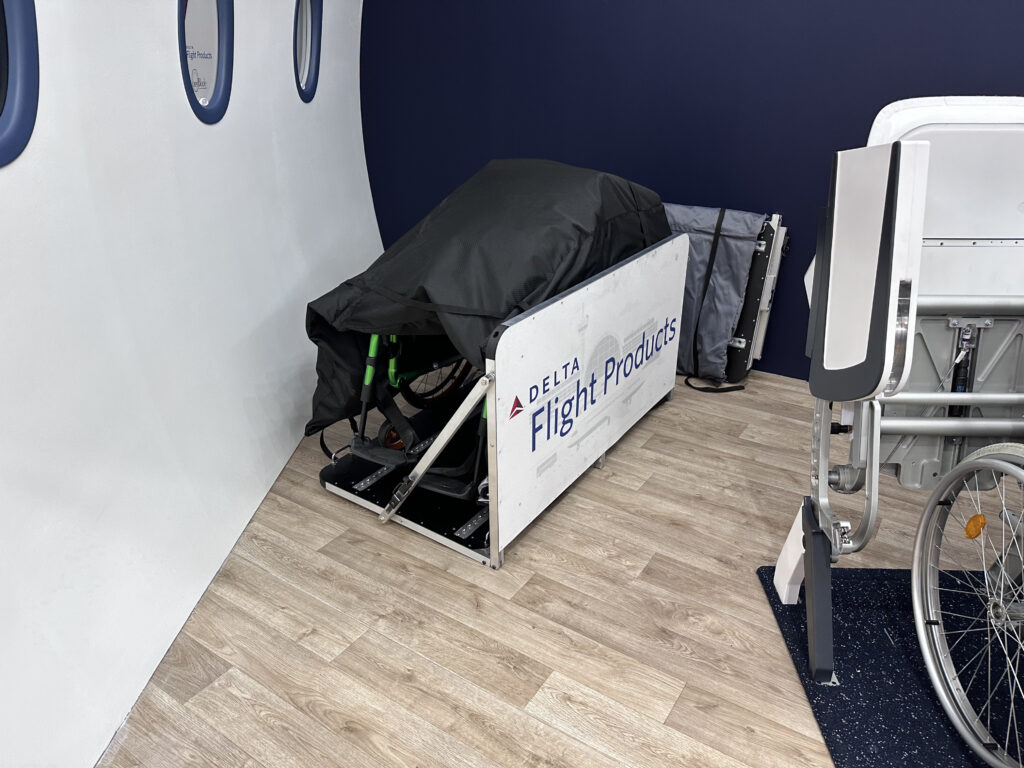HAMBURG — One of the most positive trends at this year’s Aircraft Interiors Expo was accessibility for disabled people: especially for wheelchair users, people with reduced mobility, and blind and visually impaired travellers. From systems that allow wheelchair users to travel in their own chairs to lavatories that finally enable them to avoid starving and dehydrating themselves, these advances are not before time — but they are nonetheless very welcome.
Inflight wheelchair position systems
Joining Delta Flight Products’ expanded Air4All wheelchair seating system is Collins Aerospace’s (unnamed) solution for onboard wheelchair accommodation, an early mockup of which Runway Girl Network toured at AIX.
The idea is that the regular cupboard monument that extends to the aisle at the front of the cabin is exchanged for a monument that extends just 40-50cm (15-20 inches) into the cabin, and that the space gained is used for a standard wheelchair Q’STRAINT-style restraint system set into the floor, installed in front of the airline’s regular front row seating (whether in two-across recliners as shown, or in three-across economy seats).
Collins said that the system will be “compatible with most WC19 and ISO 7176-19 transport-certified powered wheelchair devices”.
When in use by a wheelchair passenger, a full-sized, height-adjustable table unfolds from the monument in front of the wheelchair passenger.
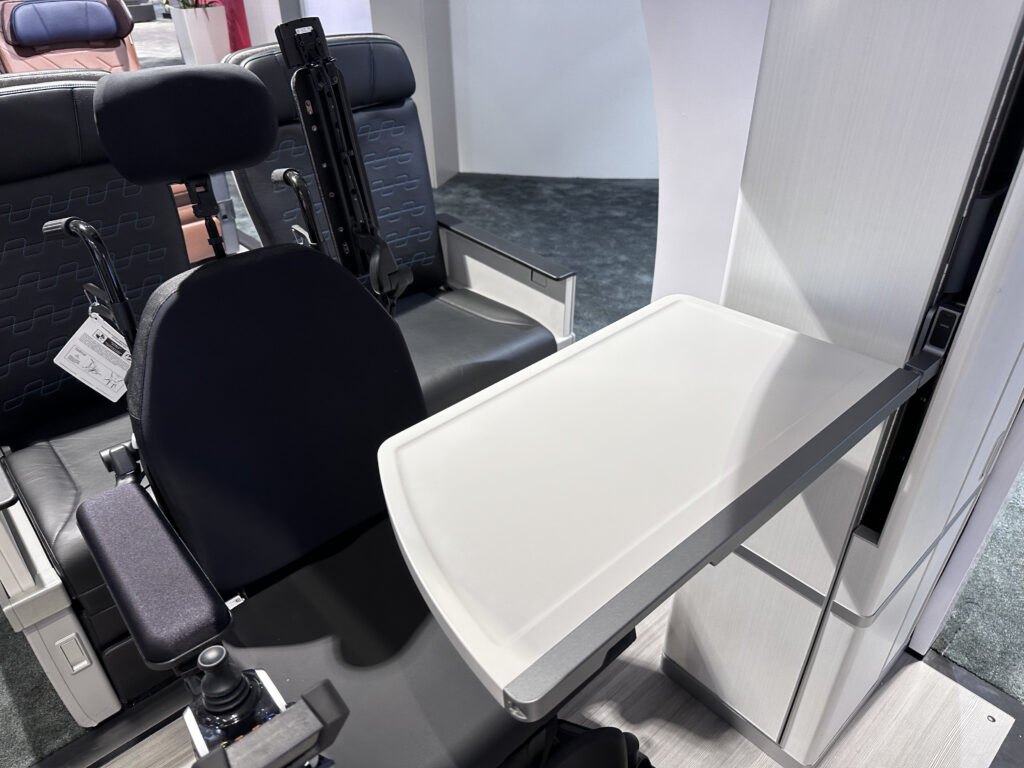
A sizeable table folds down, but would block the window passenger from getting out of their seat. Image: John Walton
When the system is not being used to accommodate a wheelchair, a door folds out to separate the space from the galley, and the table can be used by crew.
Provision for a USB charging port is available, but there is no inflight entertainment since the wheelchair passenger is in front of the regular seat and out of viewing range of the IFE arm.
There’s a core question about the window seat (or, in an economy installation, window seats) next to and behind the wheelchair, but this is one for airlines: they can add inches between this row and the bulkhead to enable independent egress to the aisle during flight, or decide to sell this seat only to a companion in the event that a wheelchair passenger is travelling.
Accessible lavatories
In addition to its work on Air4All, Delta Flight Products also had a new accessible lavatory on show, and it’s impressively advanced. Wide doors open into a space roughly twice the size of an average lavatory, with the toilet itself positioned opposite the doors facing diagonally into the space.
There is a generous amount of space allocated for transfer, as well as a well-developed series of grab bars and rails, including one that descends from the ceiling, activated through touch or touchless controls. DFP product innovation manager Tyler Anderson-Lennert explained to RGN that a substantial proportion of wheelchair users have the upper body strength to self-transfer with the use of an overhead grab bar, so its inclusion grants independence in the transfer process to those users.
Overall, this is the most impressive accessible lavatory concept presented in recent memory: it acknowledges that space does need to be dedicated to provide accessibility, DFP has clearly consulted disabled passengers, and (as a strong positive note) it resembles accessible lavatories in other travel contexts like trains.
The other accessible lavatory on show was from Collins Aerospace. The concept here is essentially two tiny lavatories with a sliding door in between.
This, the relatively early mockup model, moves the cramped, unpopular Space-Flex style convertible lavatory pair at the rear of the aircraft to the last three rows, positioned on one side at the rear of the cabin, directly opposite two or three rows of passengers.
This might satisfy the regulatory direction to establish a bare minimum of accessibility on board, but it stands in stark contrast to the DFP example: it requires flight attendants to block off both lavatories, is not accessible for as wide a range of disabled people, and there is a significant lack of dignity and privacy from being right next to so many passengers. (To this latter point, Collins executives highlighted that mid-cabin lavatories already exist on some narrowbodies.)
A curtain could enable the barest modicum of additional privacy (visual only, though). But one is left asking the question of whether the industry truly cannot do better.
Improved transport of wheelchairs
Returning to Delta Flight Products, it is also developing a new cargo loading device for wheelchairs that do need to go into the aircraft hold. This is, in essence, a flip-up L-shaped plinth to which the wheelchair can be safely secured, even in the presence of the wheelchair’s user to provide guidance, and then the plinth (rather than the chair) is secured safely in the cargo bay.
Boeing, too, is thinking about how to protect wheelchairs in the hold. The accessibility-focussed section of its stand included its High Value Cargo Container, a concept for a Universal Load Device-style cargo container with supports to strap down relatively large, high-value items including power wheelchairs.
Designing for low vision and blind people
Boeing’s stand also contained several physical representations of ways that airlines can improve accessibility in the passenger journey. These include using higher contrast at key passenger touchpoints for people who are blind or have visual impairments. These travellers can also benefit from raised lettering and iconography on interiors.
In an element rarely explored, too, Boeing is looking into the use of directional tactile wayfinding within the cabin: essentially, lines of converging raised dots on a surface that guide a blind or vision-impaired passenger to a piece of information, control or switch.
Within an industry where accessibility has often trailed behind aesthetics — seat controls with tiny icons in a line with no tactile buttons, capacitive touchscreens without any non-visual controls, and so on) it’s good to be at least having these discussions, but strong action needs to be taken, especially within the seat design and production process, more urgently.
Related Articles:
- First look at Air4All economy wheelchair system, recliner model update
- US DOT’s expanded lav rule for narrowbodies still a decade away
- Air4All wheelchair seat space wows with simplicity and elegance
- Collins to unveil onboard wheelchair accommodation at AIX
- Why United’s decision to add Braille to its cabins is profound
- How Diehl and HAECO have reimagined the single-aisle premium cabin
- ST Engineering gains traction for ACCESS accessible lavatory
- Ideas abound as US DOT eyes wheelchairs in the cabin
Featured image credited to John Walton




